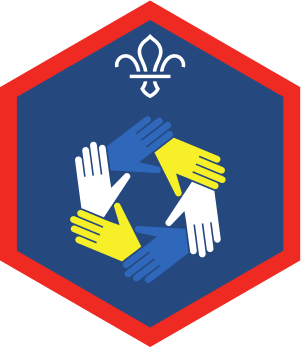Tripod football
You’ll need
- Bamboo canes
- Rope
- Footballs
- Something to mark lines (for example, chalk, masking tape, or rope)
Before you begin
- Use the safety checklist to help you plan and risk assess your activity. Additional help to carry out your risk assessment, including examples can be found on our safety pages.
- Mark out a football pitch in your meeting space with chalk or tape. The space should have two halves with a goal at either end.
Build tripods
- Put three poles next to each other. Make sure they’re lined up so the bottoms are even.
- Use a clove hitch to attach the rope to one of the outside poles. Attach the rope about 15cm from the top of the pole.
- Wrap the short tail around the long end of the rope.
- Make seven or eight wrapping turns (wrap the rope around all three poles at once).
- Put the end of the rope between the middle pole and the pole with the clove hitch on. Make two frapping turns (wrap the rope around the wraps of rope you made in step four).
- Pull the frapping turns tight.
- Move the end of the rope across the middle pole and put it between the middle pole and the other outside pole.
- Make another two frapping turns and pull them tight.
- Tie a clove hitch around the outside pole that doesn’t have a clove hitch on already. Leave a length of rope to act as the tripod’s handle.
- Stand up the tripod by crossing the outside legs under the middle pole.
Set up the pitch
- Everyone should split into two teams.
- Everyone should take it in turns to place their tripods on the pitch. Each player should be two metres away from others – the tripods may need to be more spaced out than this if players can move around their tripod a little.
- Each player should stand by their tripod and hold the rope handle.
Play tripod football
- Each team should work together to score a goal, playing football as normal but without letting go of their rope handle or moving their tripod. This will make it easy to stay two metres apart while playing.
- If the ball goes out of play, it should go to the team who weren’t last to touch it. No one should leave their tripods: the person leading the activity should kick it back to the nearest player on the team that gained control.
- If a team scores a goal, the other team get control of the ball. The person leading the game should kick the ball back to their player who’s closest to the middle of the pitch.
Reflection
This activity featured a pioneering twist on a classic sport. The tripods changed how people worked as a team and moved their bodies. Did the new rules make it easier or harder than a regular game of football? People could think about how it was tricky to rely on a good stance and passing technique (because they couldn’t move around the pitch), but how they were able to take more time passing the ball because there wasn’t any tackling. Can anyone think of other sports that could be adapted to make it easier to stay socially distanced? Could any sports be changed to use pioneering?
Safety
All activities must be safely managed. You must complete a thorough risk assessment and take appropriate steps to reduce risk. Use the safety checklist to help you plan and risk assess your activity. Always get approval for the activity, and have suitable supervision and an InTouch process.
- Active games
The game area should be free of hazards. Explain the rules of the game clearly and have a clear way to communicate that the game must stop when needed. Take a look at our guidance on running active games safely.
- Poles and long objects
Be careful when moving poles or long items. Take care if the ends are sharp. Have appropriate supervision for this activity.
- It’s up to you how big you make the goals and what size ball you play with.
- People may be able to make the tripods independently or you may need to demonstrate each step for them to copy at a safe distance.
- If people are letting go of their rope handles, you could introduce a penalty.
If anyone doesn’t want to hold the rope because of how it feels, they could make a handle cover with some fabric or even some modelling clay. Chat to them to find out what materials they’d be comfortable holding.
All Scout activities should be inclusive and accessible.


